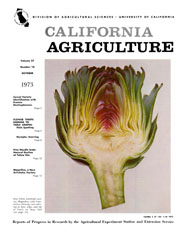


University of California
California Agriculture
|
|||
|
|||

Cover:
New Globe artichoke variety, Magnifico, with crosssection showing rose coloring
at base, edge, and tip of bracts on large bud.
October 1973
Volume 27, Number 10 News and opinion |
|||
|
University of California, 1301 S. 46th St., Bldg. 478 Richmond, CA
|